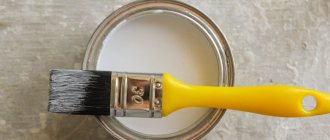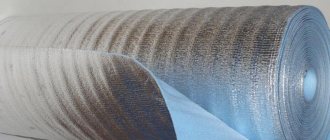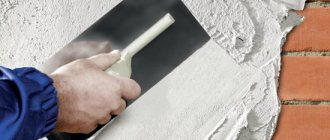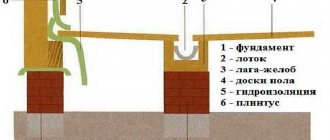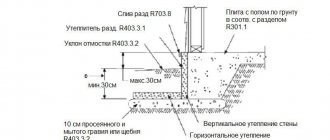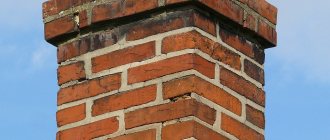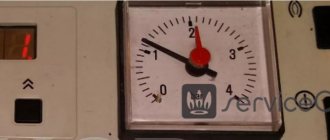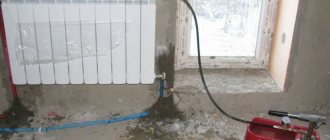When choosing insulation, a special place is occupied by foamed polyethylene - a material with sound, heat and vapor barrier properties. Depending on the manufacturer, it can be penofol, isolon or polyfoam. The construction market offers different types: with one-sided or double-sided foil, as well as with a self-adhesive plane. The material on which the insulation is attached also varies. Based on all the parameters, you need to be able to choose the appropriate adhesive for polyethylene foam.
Adhesive for penofol (click to enlarge)
Features of penofol fastening
Penofol (isolon) is produced by special foaming of polyethylene. The insulation is covered with aluminum foil, which maximizes heat retention. It is used for internal and external work, in finishing production mechanisms, preserving heat in pipelines or air conditioning systems. It comes in rolls and individual plates. It may have additional characteristics – thickness, color. The bonding of foil to the plane of foamed polyethylene can be chemical or physical (cross-linked).
Pros of penofol:
- small thickness;
- environmentally friendly;
- does not require additional skin and respiratory protection;
- there is no need for special tools;
- ease of fastening.
We attach penofol to glue (click to enlarge)
Glue is used for penofol with foil on one side.
Double-sided insulation is used for thermal insulation of loggias, garages, and pipes. They are attached to the sheathing or purchased polyethylene foam with a self-adhesive surface.
Due to the lightness of the insulation material, the load-bearing capacity of the adhesive is not so important.
Secret. How to glue foil insulation to a wall.
The main advantages of penofol are its small size and minimal thickness. And, most importantly, the usable area of the room finished with this material remains the same as it was before processing.
It can be used as a separate thermal insulation material and as one of the elements used for furnishing premises.
That is why insulation with penofol is most often carried out.
Penofol
Penofol is foamed polyethylene, covered on one or both sides with aluminum food foil. The thickness of the finished insulation does not exceed 10 millimeters.
The popularity of penofol as a building material is explained by its properties: it does not absorb thermal energy accumulated in the room, but reflects it. The purpose of this material is to retain warm air in winter and cool air accumulated in the room during morning ventilation in summer.
Insulation
Penofol can be used in other cases, for example, for insulation:
- piping systems;
- premises from external noise;
- hydro and steam systems;
- ventilation shafts.
It is also often used as a reflector of the thermal energy of a heating radiator, as an attribute for the artistic decoration of ceiling, floor or wall surfaces.
Types of penofol
The most common option is a material covered with foil on only one side. It is marked "A". Most often, craftsmen prefer to lay it.
There are also other types of penofol:
- covered with foil on both sides (marked “B”);
- on one side there is foil, and on the other there is a self-adhesive coating (a product of this type is marked with the letter “C”);
- there is a metal layer on both sides, with one of the foil sides covered with an additional layer of film (this type is marked with the letters “ALP”);
- Only one side is covered with foil, the other is equipped with a relief pattern (such products are marked “M” and “R”).
We invite you to familiarize yourself with the installation of a chimney in a bathhouse for a gas stove
Penofol, marked with the letters “AIR”, is used to equip air ducts. Products that are used for heating mains, o. As an independent heat insulator, only penofol marked “C” is used, however, provided that the room temperature does not drop to very low levels.
Advantages of foil material
Even a person who does not have the skills of a builder can easily cut this material and apply it to any surface. Since the main components of the product are polyethylene and food foil, rodents and all kinds of household pests are indifferent to penofol.
The material is environmentally friendly and will not ignite even if other household items catch fire. Due to the fact that the product practically does not allow steam to pass through, it is widely used to insulate public and home saunas.
Regarding the disadvantages, it is better to insulate with penofol from the inside. The product is not recommended for use when finishing the outside of a living space. It is difficult to fix with glue and adhesive solution, and if fixed with nails, it can tear. Penofol is inconvenient from a technological point of view - this material is difficult to “disguise” due to the softness of its structure.
Bonding penofol
In order to work with this material quickly and achieve a satisfactory result, you need to know some installation features. This will create reliable insulation that will last for many decades.
The following rules must be followed:
- There should be air space between the foam layer and the wall.
- For gluing to concrete, the surface must be prepared: leveled, cracks eliminated, primed.
- Carefully seal all joints of individual insulation sheets with construction tape or silicone sealant. Otherwise, depressurization of the structure may occur.
- Avoid the formation of joints at the corner joints of the ceiling and walls.
- Make sure that the foil side of the penofol does not come into contact with electrical wires and cables, since aluminum is an excellent conductor of electric current. Therefore, all possible junctions of material and wires must be insulated.
- The reflective side (the one covered with foil) should be directed indoors.
- Fragments of material should not overlap each other. Condensation may collect along the edges, resulting from moist air entering the inner surface of the heat insulator.
- Before gluing penofol to the surface, it is necessary to ensure that all areas of the panel are coated with the adhesive. During this time, the glue will dry a little (allowable time 5 - 60 seconds), due to which maximum adhesion will be achieved.
- The insulation sheet treated with glue (its non-foil side) should be pressed to the surface, then gently smoothed, holding until the sheet is completely fixed.
Insulating the house inside
Before you begin, you need to insulate the electrical wires and stock up on the necessary materials. In addition to penofol, the contractor will need assembly glue or a stapler, as well as wooden sheathing and hardware.
- The first task facing the performer of this work is the construction of a wooden frame to which the penofol will be attached. The air layer separating the insulation from the wall should not be less than 20 millimeters.
- Then, armed with glue or a stapler, you need to fix the insulation on the wooden frame, not forgetting that foil is an excellent conductor of electric current. All electrical wiring must be insulated in advance.
- Now it's time to install the second wooden frame. Finishing materials will be applied to it. The maximum thickness of the structure is 20 millimeters.
Laying insulation material on the floor
In this case, the material is usually used as an additional layer. The main ones are polystyrene foam, expanded clay or expanded polystyrene under the screed.
In addition to penofol and the main thermal insulation material, the work contractor must have on hand metal (or wooden) sheathing, tools for installation and plumbing work, an adhesive solution (or hardware), as well as wooden logs.
The following can be used as an adhesive solution:
- liquid Nails;
- Double-sided tape;
- polyurethane foam (applied in a thin layer).
Execution sequence:
- Before starting insulation work, it is necessary to level the floor using a concrete screed for this purpose. Lay a foam or expanded clay base.
- It is recommended to play the role of a wooden frame with lags impregnated with an antiseptic composition or use a metal frame. The products are laid on an insulating layer, and sheathing is placed on top of it.
Laying penofol on the ceiling
Experts recommend penofol as an ideal thermal insulator for the ceiling. This opinion is due to its low weight and small thickness, as well as the minimal amount of effort that will be required to be applied by the person carrying out the installation.
To successfully carry out the work, the contractor, in addition to penofol, will need wooden slats, hardware, tools and facing material.
- Thermal insulation of the ceiling is carried out in two steps. First, using wooden slats, the initial layer is attached to the surface. For this, the thinnest type of penofol is usually chosen. When fixing the first layer, the slats are laid in the longitudinal direction, and when attaching the next layer, in the transverse direction.
- Insulating materials are covered with cladding made of foam plastic or other lightweight materials.
Insulating a building or an individual apartment helps retain heat in cold weather and maintain a constant indoor climate throughout the entire year.
This saves money on building maintenance. Thermal insulation is used to insulate various building structures: floors, ceilings, loggias, attics.
The insulator is also used for buildings for various purposes - bathhouses, garages, country houses, barns. They are available in different thicknesses, lengths and widths.
Insulating material with foil glued to it has been used for many years. It is especially beneficial to use insulation with foil for walls.
Foil gives a reflective effect and helps to additionally retain heat in the room. Each type of insulating material has its own properties, which give some advantages to each over the others.
We invite you to familiarize yourself with decorating walls in a bathhouse with your own hands
Foamed polyethylene has significant strength. Therefore, it is better to use it for floor insulation. Stone wool material can withstand high temperatures.
It is well suited for chimneys, saunas, baths, and heating mains. In addition to its insulating properties, thermal insulation of all types is a good soundproofing material.
Insulation with foil for walls is used in most cases based on fiberglass. This material has a number of good qualities: good vapor barrier, low density and increased flexibility, non-flammable, environmentally friendly, does not emit odor, durable, not high price.
It is also used for insulating basements, ventilation ducts, baths, loggias, and attics. With the same effect, thermal insulation with foil based on stone wool and polyethylene foam can be used to insulate surfaces, especially indoors.
The choice of insulation comes down to selecting its thickness depending on the surface design, climate zone and thermal insulation properties of the selected material.
Insulation materials are manufactured in thicknesses from 10 mm to 150. Therefore, after calculation, the required thickness of the insulation can be assembled.
Thermal insulation should be done in warm and dry times. Before performing this work, they must be cleaned of foreign objects, dirt, and dust.
It is necessary to repair cracks and chips in brick walls, remove peeling paint and plaster. After this, they must be primed and treated with an antiseptic.
- 24 November 2014 15:14:48
- 6724
Glue selection
The range of adhesives for penofol on the modern market is quite wide. Therefore, it is important to take into account the different characteristics of materials.
General rules
Penofol adhesive is selected based on the following:
- the product has durable adhesive properties;
- the thermal range coincides with the temperature characteristics of the insulation;
- a non-toxic certified product is used in the interior decoration of residential premises (apartment, office);
- for external finishing, you need glue that is resistant to temperature changes and weather conditions;
- saunas and baths require mixtures with water-repellent properties;
